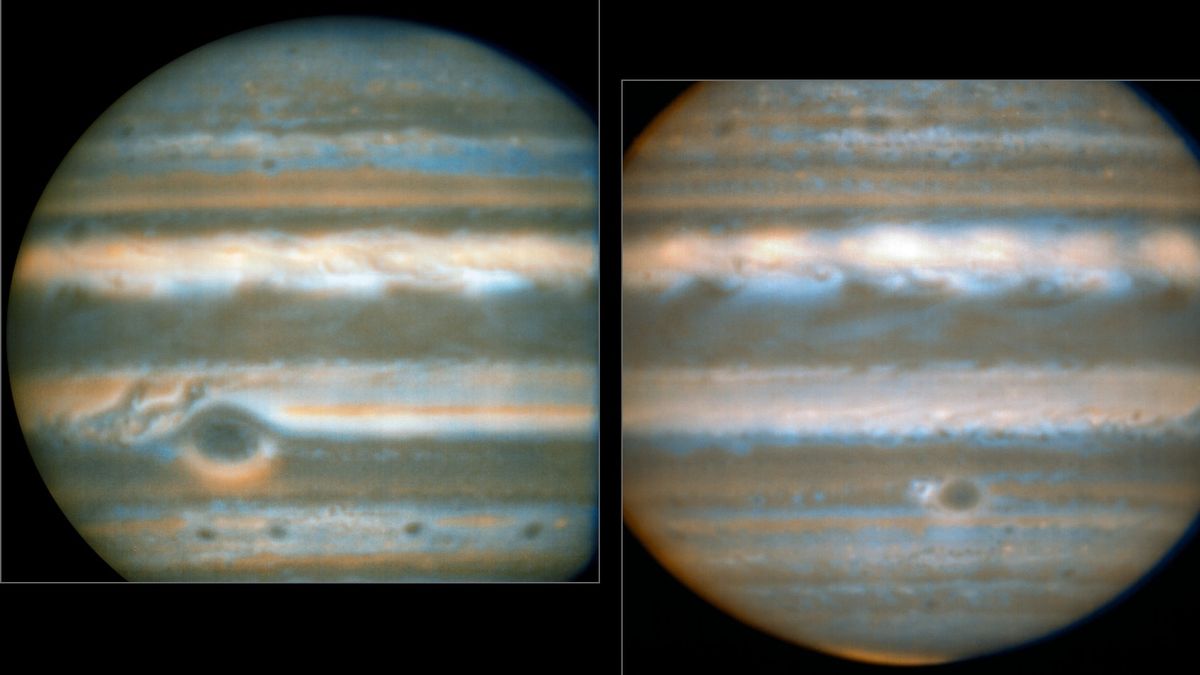
Something odd is happening in Jupiter's atmosphere, a new study has revealed.
Forty years' worth of measurements of Jupiter's atmosphere by spacecraft and ground-based telescopes have revealed strange weather patterns on the largest planet of the solar system, including hot and cold periods during its long year (equivalent to 12 Earth years). But Jupiter isn't going through seasonal changes like Earth does.
On Earth, weather transitions between winter, spring, summer and fall are a result of the tilt of the planet's axis toward the plane in which it orbits the sun. This 23-degree tilt makes different parts of the globe receive varying amounts of sunlight throughout the year. But Jupiter's axis is tilted toward the giant planet's orbital plane by only 3 degrees, meaning that the amount of sun rays reaching different parts of Jupiter's surface throughout its long year barely changes. Still, the new study found periodic temperature swings taking place around the planet's cloud-covered globe.
Related: Jupiter, too! New James Webb photos show giant planet's rings, moons and more
"We've solved one part of the puzzle now, which is that the atmosphere shows these natural cycles," Leigh Fletcher, an astronomer at the University of Leicester in the U.K. and a co-author of the new paper, said in a NASA statement (opens in new tab). "To understand what's driving these patterns and why they occur on these particular timescales, we need to explore both above and below the cloudy layers."
The team has found indications that these unseasonal seasons may have something to do with a phenomenon known as teleconnection. Teleconnection describes periodic changes in aspects of a planet's atmospheric system that occur simultaneously in parts of the globe that are seemingly unconnected and could lie thousands of miles or kilometers apart.
Teleconnection has been observed in Earth's atmosphere since the 19th century, most notably in the famous La Nina – El Nino cycle, also known as the Southern Oscillation. During these events, changes in the trade winds of the western Pacific Ocean correspond with changes in rainfall across much of North America, according to the National Oceanic and Atmospheric Administration (NOAA).
In the new research, the scientists found that on Jupiter, when temperatures rise at specific latitudes in the northern hemisphere, the same latitudes in the southern hemisphere cool off, almost like a perfect mirror image.
"That was the most surprising of all," Glenn Orton, a planetary scientist at NASA's Jet Propulsion Laboratory in California and lead author of the study, said in the statement.
"We found a connection between how the temperatures varied at very distant latitudes," he said. "It's similar to a phenomenon we see on Earth, where weather and climate patterns in one region can have a noticeable influence on weather elsewhere, with the patterns of variability seemingly 'teleconnected' across vast distances through the atmosphere."
The measurements also revealed that when temperatures rise in the stratosphere, the upper layer of Jupiter's atmosphere, they fall in the troposphere, the lowest atmospheric layer, where weather events occur, including Jupiter's powerful storms.
The study included data from 1978 onward, gathered by some of the best ground-based telescopes, including the Very Large Telescope in Chile, NASA's Infrared Telescope Facility and the Subaru Telescope at the Mauna Kea Observatories in Hawaii. The researchers also used data from spacecraft such as the deep-space Voyager probes, which flew past Jupiter in 1979, and the Cassini mission, which flew past Jupiter in 2001 on its way to explore Saturn.
Related stories:
"Measuring these temperature changes and periods over time is a step toward ultimately having a full-on Jupiter weather forecast, if we can connect cause and effect in Jupiter's atmosphere," Fletcher said in the statement. "And the even bigger-picture question is if we can someday extend this to other giant planets to see if similar patterns show up."
Previously, scientists knew that Jupiter's atmosphere features colder regions that appear in lighter colors and warmer regions that appear as brownish bands. The new study, which covers a period of three Jovian years, for the first time reveals how these patterns change over longer periods of time.
The study (opens in new tab) was published in the journal Nature Astronomy on Monday (Dec. 19).
Follow Tereza Pultarova on Twitter @TerezaPultarova. Follow us on Twitter @Spacedotcom and on Facebook.
Article From & Read More ( Something weird is happening in Jupiter's atmosphere, 40-year study shows - Space.com )https://ift.tt/ERh5gDX
Science
No comments:
Post a Comment